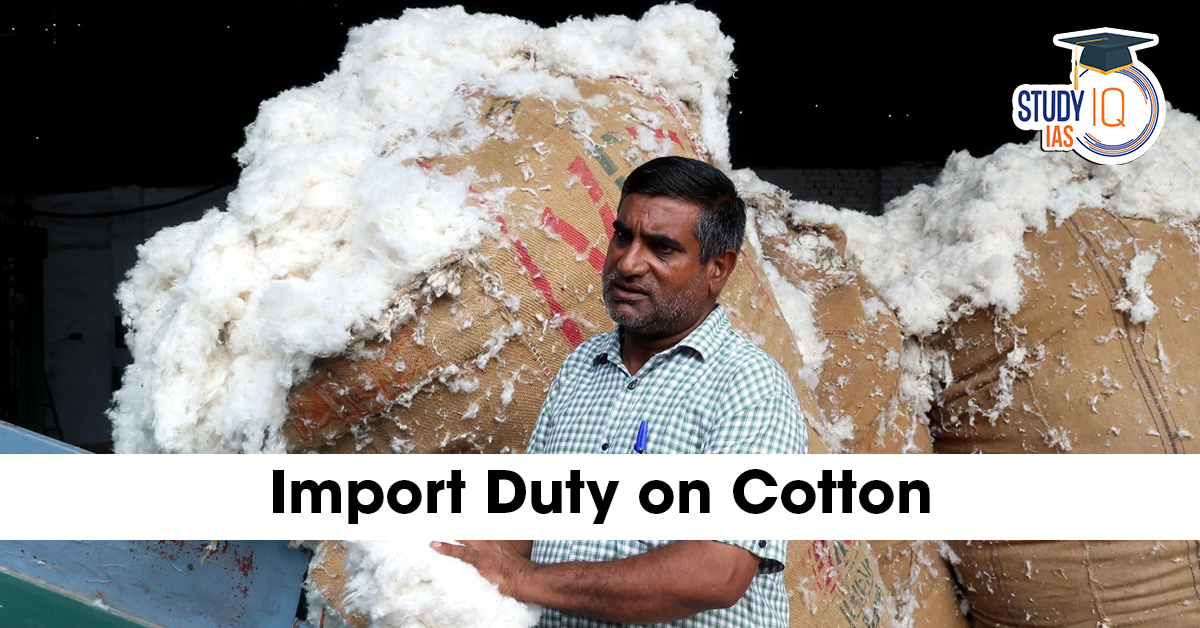Table of Contents
Context: The government has suspended import duty on cotton in 2024–25 to address falling domestic production and rising raw material costs for the textile industry.
Suspension of Import Duty on Cotton
| About Cotton |
|
Current Situation (2024–25)
- Production Decline: Down to 294 lakh bales (lowest in 15 years) vs demand of 318 lakh bales.
- Imports Rising:
- 40 lakh bales projected (highest ever).
- Import value: $1.20 billion (107% surge from last year).
- Key suppliers: Australia, U.S., Brazil, Egypt.
Implications of Duty Withdrawal
For Industry & Exporters (Positive)
- Imported cotton becomes cheaper → lowering raw material cost.
- Garment exporters get a level playing field in international markets.
- Beneficial during a raw material shortage.
For Farmers (Negative)
- Removal of duty may discourage cotton cultivation.
- Farmers fear lower domestic prices due to cheaper imports
Why is Cotton Production Declining in India?
- Pink Bollworm (PBW)
- PBW is a pest whose larvae damage cotton bolls (fruits), destroying seeds and lint (cotton fibre).
- It has developed resistance to Bt cotton (a GM variety used in India).
- No New GM Approvals 🧬
- Existing Bt cotton (with cry1Ac and cry2Ab genes) is now ineffective.
- New GM hybrids developed by Indian companies are stuck in regulatory trials.
- No GM crop has been commercialised since 2006 due to opposition and long approval processes.
- Climate Change: Erratic rainfall, unseasonal rains and long dry spells affect cotton growth.
- Low Profitability: Rising input costs (seeds, fertilisers, pesticides).
- Monocropping & Poor Crop Rotation: Continuous cotton cropping without rotation → soil nutrient depletion and pest buildup.
Long-Term Solutions Suggested
- Stable Policy Framework: Suspend duty during non-peak season (April–Sept) to balance farmer & industry interests.
- Financial Support to Mills: 5% interest subvention on working capital for mills to buy cotton during peak season.
- This reduces the government. burden on MSP operations.
- Boost Productivity: Better seeds, modern cultivation practices, and pest control to raise yields.
- Diversified Cotton Sources: Promote organic/extra-long staple cotton domestically to reduce import dependence.
- Seed Innovation: Fast-track next-gen GM/CRISPR cotton under strict biosafety + public sector R&D.
- Diversification: Encourage crop rotation (soybean, pulses) to reduce pest cycles + soil degradation.
- Water-Smart Cotton: Promote drip irrigation + organic cotton in water-stressed regions.


 Out-of-Pocket Health Expenditure, Reason...
Out-of-Pocket Health Expenditure, Reason...
 Treasury Bills (T-bills): RBI Cuts Holdi...
Treasury Bills (T-bills): RBI Cuts Holdi...
 Fisheries Sector in India, Current Statu...
Fisheries Sector in India, Current Statu...

























